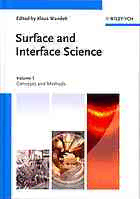Table Of ContentEditedby
KlausWandelt
SurfaceandInterfaceScience
SurfaceandInterfaceScience
EditedbyKlausWandelt
Volume1:ConceptsandMethods
Volume2:PropertiesofElementalSurfaces
ISBN978-3-527-41156-6
Volume3:PropertiesofCompositeSurfaces:Alloys,Compounds,Semiconductors
Volume4:Solid-SolidInterfacesandThinFilms
ISBN978-3-527-41157-3
Volume5:Solid-GasInterfacesI
Volume6:Solid-GasInterfacesII
ISBN978-3-527-41158-0
Volume7:Solid-LiquidandBiologicalInterfaces
Volume8:ApplicationsofSurfaceScience
ISBN978-3-527-41159-7
Edited by Klaus Wandelt
Surface and Interface Science
Volume 4: Solid-Solid Interfaces and Thin Films
TheEditor AllbookspublishedbyWiley-VCHare
Prof.Dr.KlausWandelt carefullyproduced.Nevertheless,authors,
UniversityofBonn editors,andpublisherdonotwarrantthe
InstituteforPhysicaland informationcontainedinthesebooks,
TheoreticalChemistry includingthisbook,tobefreeoferrors.
[email protected] Readersareadvisedtokeepinmindthat
statements,data,illustrations,procedural
CoverPicture: detailsorotheritemsmayinadvertentlybe
DesignbyKlausWandeltand inaccurate.
SpieszDesign,Neu-Ulm
PicturesbyH.Gao,J.Mao,andY.Wang LibraryofCongressCardNo.:appliedfor
BritishLibraryCataloguing-in-Publication
Data
Acataloguerecordforthisbookisavailable
fromtheBritishLibrary.
Bibliographicinformationpublishedbythe
DeutscheNationalbibliothek
TheDeutscheNationalbibliothek
liststhispublicationintheDeutsche
Nationalbibliografie;detailedbibliographic
dataareavailableontheInternetat
<http://dnb.d-nb.de>.
©2014Wiley-VCHVerlag&Co.KGaA,
Boschstr.12,69469Weinheim,Germany
Allrightsreserved(includingthoseof
translationintootherlanguages).Nopart
ofthisbookmaybereproducedinany
form–byphotoprinting,microfilm,orany
othermeans–nortransmittedortranslated
intoamachinelanguagewithoutwritten
permissionfromthepublishers.Registered
names,trademarks,etc.usedinthisbook,
evenwhennotspecificallymarkedassuch,
arenottobeconsideredunprotectedbylaw.
CoverDesign Grafik-DesignSchulz,
Fußgo¨nheim
Typesetting LaserwordsPrivateLimited,
Chennai,India
Printing StraussGmbH,Mo¨rlenbach
PrintedintheFederalRepublicofGermany
Printedonacid-freepaper
PrintISBN:978-3-527-41157-3
oBookISBN:978-3-527-68056-6
V
Contents
Volume3
Preface XIII
TheEditor XV
ListofContributors XVII
Abbreviations XXIII
11 SurfacePropertiesofAlloys 1
TobiasC.KerscherandStefanMu¨ller
12 PropertiesofSurfaceAlloys 61
HarryHoster
13 SurfacesofCompoundSemiconductors 101
PatrickVogtandNorbertEsser
14 PhysicalPropertiesofSurfaceSilicides 177
E.G.Michel
15 PropertiesofOxideSurfaces 229
MartinSterrerandHans-JoachimFreund
16 SurfacesofSimpleIonicCrystals 279
AnnemariePucci,JochenVogt,HelmutWeiß,
andMichaelReichling
17 SurfacesofIce 305
YoshinoriFurukawa,GenSazaki,andHirokiNada
18 SurfacesofQuasicrystalsandComplexMetallicAlloys 349
PatriciaA.ThielandRonanMcGrath
VI Contents
19 SurfacesofAmorphousMaterials 383
EnricoBarlettaandKlausWandelt
Volume4
20 EpitaxialGrowthofThinFilms 421
HaraldBrune
20.1 Introduction 422
20.1.1 TechnologicalApplicationsofEpitaxialThinFilms 422
20.1.2 EpitaxialThinFilmVersusCrystalGrowth 424
20.2 DepositionTechniques 425
20.2.1 PhysicalVaporDeposition 426
20.2.2 ChemicalVaporDeposition 427
20.2.3 AtomicLayerDeposition 429
20.2.4 ElectrochemicalDeposition 430
20.3 GrowthModes 431
20.4 Nucleation 435
20.4.1 AtomicProcesses 435
20.4.2 HomogeneousNucleation 438
20.4.3 NucleationinthePresenceofLong-RangeInteractions 442
20.4.4 HeterogeneousNucleation 446
20.5 IslandShapes 449
20.5.1 Fractals 450
20.5.2 CompactAdatomandVacancyIslands 455
20.6 CoarseningofMonolayerIslands 457
20.6.1 TheOstwaldRipening 458
20.6.2 TheSmoluchowskiRipening 463
20.7 GrowthMorphologies 465
20.7.1 GrowthOscillations 465
20.7.2 ‘‘WeddingCakes’’ 467
20.8 GrowthManipulation 468
20.8.1 Layer-DependentAdatomMobilities 469
20.8.2 Surfactants 470
20.8.3 PeriodicIonBombardment 475
FurtherReading 477
Acknowledgments 478
References 478
21 QuantumWellStatesinMetallicFilms,Wires,andDots 493
PetarPervan,MiloradMilun,andRadovanBrako
21.1 Introduction 493
21.1.1 CriticalDimensions 494
21.1.1.1 DiscretizationandTemperature 496
21.1.2 SpatialEffectsofEnergyDiscretization 497
Contents VII
21.1.3 MomentumofDiscreteStates 498
21.2 TheTypesofMetallicQuantumWells 499
21.2.1 2DQuantumWells–UltrathinFilms 500
21.2.1.1 MultilayerUltrathinFilms 500
21.2.1.2 Single-LayerUltrathinFilms 501
21.2.2 1DQuantumWellNanowires 501
21.2.2.1 Nanostripes 502
21.2.2.2 MonoatomicWires 502
21.2.2.3 AtomicChains 503
21.2.3 0DQuantumWells–Nanodots 504
21.3 ElectronicPropertiesofQuantumWells–Dimensional
Aspects 504
21.3.1 3DMetals–Free-Electron-LikeMetals 504
21.3.2 2DQuantumWells;UltrathinFilms 505
21.3.3 1DQuantumWells;Nanowires 513
21.3.4 0DQuantumWells;Nanodots 517
21.4 QuantumWellPotentials 518
21.4.1 InfiniteversusFinitePotentialWells 519
21.4.2 InterfaceBarrier–EnergyGap 521
21.4.3 InterfaceBarrier–SymmetryGap 523
21.4.3.1 HybridizationEffects 526
21.4.4 VacuumBarrier–ImagePotential 528
21.4.5 PeriodicPotential 529
21.4.5.1 SpectroscopicEffects 530
21.5 ModelingofQuantumWells 532
21.5.1 PhaseAccumulationModel(PAM) 532
21.5.2 TheFabry–PerotModel 536
21.5.3 DensityFunctionalTheory 538
21.6 ConcludingRemarks 541
References 541
22 Thin-FilmMagnetism 545
RolfAllenspach
22.1 Introduction 545
22.2 OscillatoryInterlayerExchange 547
22.2.1 ABriefHistoryofInterlayerExchangeCoupling 547
22.2.2 ExperimentalApproaches 548
22.2.3 SpacerMaterials,Periods,andCouplingStrengths 550
22.2.4 QuantumWellStates 552
22.3 MagneticAnisotropyinFilms 555
22.3.1 TheConceptofSurfaceAnisotropy 556
22.3.2 SpinReorientation 559
22.3.3 Anisotropies:2Dversus1D 562
22.3.4 AnisotropiesInducedbyQuantumWellStates 567
22.3.5 InterfaceAnisotropyApplied:ExchangeBias 569
VIII Contents
22.4 MagneticDomainsandDomainWalls 571
22.4.1 MagnetizationPatternsinUltrathinFilms 572
22.4.2 MagneticDomainWallsinUltrathinFilms 574
22.4.3 DomainWallMotion:theInfluenceofInterfacesandEdges 577
References 578
23 UltrathinOxideFilms 585
GaetanoGranozziandStefanoAgnoli
23.1 Introduction 585
23.1.1 AnHistoricalOverviewonThinFilmScience 585
23.1.2 DefinitionoftheSelvedgeandoftheDifferentDepthRegimes 586
23.1.3 GeneralConceptsRegardingthePreparationandCharacterization
ofThinFilms 587
23.1.3.1 ThinFilmPreparation 587
23.1.3.2 ThinFilmCharacterization 589
23.1.4 TheScopeofThisChapter 590
23.2 OxideUltrathinFilms:GeneralConsiderations 592
23.2.1 WhyUltrathinOxideFilms? 592
23.2.2 PreparativeAspects 593
23.2.2.1 SurfaceOxidation(SO)oftheSubstrate 594
23.2.2.2 FilmDepositionandPostdepositionTreatments 596
23.2.3 PhysicochemicalAspectsofInterfaceswithOxides 597
23.2.3.1 EquilibriumStructureandChemistryofaGenericInterface 597
23.2.3.2 PeculiaritiesofInterfacesInvolvingOxides 598
23.3 OxideFilmsonMetalSubstrates 599
23.3.1 SpecificAspectsoftheOxide/MetalInterface 599
23.3.2 CaseStudies 602
23.3.2.1 Rock-Salt-LikeOxidesonDifferentMetals:theRoleofStrain 602
23.3.2.2 VariableValenceOxidesonDifferentMetals:theRoleofOxygen
ChemicalPotential 608
23.3.2.3 Al O FilmsonMetalAlloys:theRoleofTemperatureand
2 3
Kinetics 614
23.4 OxideFilmsonOxideSubstrates 618
23.4.1 SpecificAspectsoftheOxide/OxideInterface 618
23.4.2 CaseStudies 621
23.4.2.1 Rock-Salt-LikeOxides:theSimpleCube-On-CubeEpitaxy 621
23.4.2.2 VariableValenceOxides:AccommodatingDifferentLattices 623
References 635
24 FromOrderedtoVitreousOxideFilms 641
MarkusHeyde,GeorgH.Simon,andLeonidLichtenstein
24.1 Introduction 641
24.2 Experiment 642
24.3 PointDefectsinMagnesia 645
24.3.1 PristineMagnesiaFilms 646
Contents IX
24.3.2 ColorCentersinMagnesia 647
24.3.3 AssignmentofColorCenters 649
24.4 LineDefectsinAlumina 652
24.4.1 AluminaFilmonNiAl(110) 653
24.4.2 AtomicSitesintheSurfaceUnitCell 655
24.4.3 AtomicArrangementinDefectNetworks 659
24.4.3.1 ExplainingAPDBStructuresandTheirJunctions 660
24.4.4 ComplexDomainBoundaryNetwork 663
24.4.5 SpectroscopyAcrossExtendedLineDefects 667
24.5 AtomicStructureofaThinVitreousSilicaFilm 668
24.5.1 AssignmentofAtomicPositions 669
24.5.1.1 RangeI:TheStructuralUnit 671
24.5.1.2 RangeII:InterconnectionofAdjacentStructuralUnits 671
24.5.1.3 RangeIII:NetworkTopology 675
24.5.1.4 RangeIV:Longer-RangeDensityFluctuations 680
24.6 ConcludingRemarksandOutlook 681
Acknowledgments 682
References 683
25 GrapheneonCrystallineMetalSurfaces 691
Ye-LiangWang,Hai-MingGuo,andHong-JunGao
25.1 Introduction 691
25.1.1 ANewMemberintheCarbonFamily–Graphene 691
25.1.2 UniquePropertiesandApplicationPotentialsofGraphene 692
25.1.3 ExploringofFabricationMethodsofGraphene 694
25.2 Millimeter-Scale,HighlyOrdered,Single-CrystallineGraphene
onRu(0001) 696
25.3 EpitaxialGrowthandStructuralPropertiesofGrapheneon
Pt(111) 702
25.4 ElectronicStructureandQuantumPropertiesofGrapheneon
Ru(0001) 710
25.5 InterfacialPropertiesofEpitaxialGrapheneonMetalSubstrates 718
25.6 GrapheneMoire´TemplatefortheFormationofMonodisperse
PtNanoclusters 724
25.7 ConclusionsandOutlook 729
Acknowledgments 731
References 731
26 MolecularOrganicFilms 737
MoritzSokolowski
26.1 IntroductionandOutlineofThisChapter 737
26.2 TechnologicalandScientificMotivation 739
26.2.1 TechnologicalMotivation 739
26.2.2 ScientificMotivation 741
26.3 GeneralOutlineofanOMBDExperiment 742
X Contents
26.3.1 TheOMBDPreparationChamber 742
26.3.2 MaterialsUsedforOMBD 744
26.3.2.1 MolecularMaterials 744
26.3.2.2 SubstrateMaterials 749
26.4 HistoricBackground 751
26.5 StructuralRelations 753
26.5.1 TheGeneralGrowthScenarios 753
26.5.2 DefinitionoftheDifferentTypesofStructuralRelation 754
26.5.3 SomeExperimentalRemarks 759
26.6 EnergeticConsiderations 761
26.6.1 TheNatureoftheBondingattheInterface 761
26.6.2 AspectsofMolecularOrientationandIntermolecular
Interaction 766
26.6.3 SomeRemarksonQuantitativeValuesofEnergies 767
26.6.4 LatticeSums 769
26.6.5 LayerGrowthandStrainRelief 770
26.7 TheGrowthMorphology 772
26.7.1 SomeMethodicAspects 772
26.7.2 GeneralGrowthMorphologies 773
26.7.3 RougheningandKineticAspects 775
26.8 Summary 777
Acknowledgments 777
References 777
27 MagneticClustersonSurfaces 785
TimofeyBalashovandWulfWulfhekel
27.1 Introduction 785
27.2 3DClustersonSurfaces 787
27.2.1 SynthesisandDepositionofMetallicClusters 787
27.2.2 MagneticPropertiesofSmallClusters 788
27.2.3 Surface-InducedMagneticPropertiesofClusters 790
27.2.3.1 Hybridization 790
27.2.3.2 ChangeinClusterGeometryonSurface 790
27.2.3.3 AlloyFormation 792
27.2.3.4 Cluster–clusterInteractions 792
27.3 Two-DimensionalMagnets 792
27.3.1 EdgeVersusCoreAnisotropy 793
27.3.2 ExperimentalObservationofSingleIslands 799
27.3.3 Stacking2DStructures 799
27.4 SingleAtomsandFew-AtomClusters 801
27.4.1 OriginsoftheAnisotropy 802
27.4.2 TheQuantumMechanicalModel 803
27.4.3 DynamicPropertiesofAtoms 806
27.4.4 InteractionsBetweenAtoms 808
27.4.5 OnaWaytoSingle-atomicMagneticBits 808

